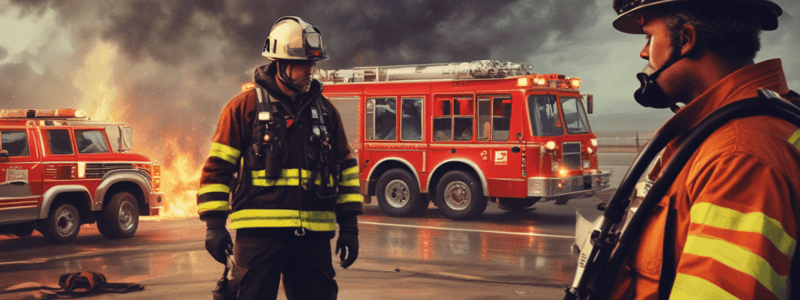Podcast
Questions and Answers
What is one of the key duties of a fire officer at the scene of an incident?
What is one of the key duties of a fire officer at the scene of an incident?
- Serving as a cook for the team
- Performing maintenance on the truck
- Distributing equipment among the team
- Assuming initial command of the incident (correct)
What does NIMS stand for?
What does NIMS stand for?
National Incident Management System
The first-arriving fire officer has the responsibility to establish ______ and manage the incident.
The first-arriving fire officer has the responsibility to establish ______ and manage the incident.
command
Which mode is used when a situation requires immediate action?
Which mode is used when a situation requires immediate action?
NIMS principles are not taught in any incident management courses.
NIMS principles are not taught in any incident management courses.
What is one of the three strategic priorities when managing an incident?
What is one of the three strategic priorities when managing an incident?
What must fire departments comply with to ensure firefighter safety in IDLH environments?
What must fire departments comply with to ensure firefighter safety in IDLH environments?
Match the following training courses with their descriptions:
Match the following training courses with their descriptions:
What is the recommended span of control for emergency operations?
What is the recommended span of control for emergency operations?
Which operational mode involves conducting an investigation of the incident?
Which operational mode involves conducting an investigation of the incident?
What is an offensive operation in firefighting?
What is an offensive operation in firefighting?
Traditionally, it was believed that attacking from outside could push the fire into other parts of the building.
Traditionally, it was believed that attacking from outside could push the fire into other parts of the building.
What does IAFC stand for?
What does IAFC stand for?
What is the primary mission of the IAFC SHS?
What is the primary mission of the IAFC SHS?
What are the two major components of an Incident Action Plan (IAP)?
What are the two major components of an Incident Action Plan (IAP)?
What does the acronym RECEO-VS stand for in tactical priorities?
What does the acronym RECEO-VS stand for in tactical priorities?
____ is the systematic process of gathering and processing information to evaluate the situation in firefighting.
____ is the systematic process of gathering and processing information to evaluate the situation in firefighting.
According to the NFPA, how many firefighters died in the line of duty in 2018?
According to the NFPA, how many firefighters died in the line of duty in 2018?
Firefighters should regularly stash spare clothes on apparatus to change into after duty.
Firefighters should regularly stash spare clothes on apparatus to change into after duty.
The first-arriving officer must make a rapid and informed choice on the priority and sequence of suppression activities versus occupant ___.
The first-arriving officer must make a rapid and informed choice on the priority and sequence of suppression activities versus occupant ___.
What are the three levels of command in the ICS?
What are the three levels of command in the ICS?
Who is responsible for establishing command at the incident?
Who is responsible for establishing command at the incident?
What are the three strategic priorities the Incident Commander (IC) must address?
What are the three strategic priorities the Incident Commander (IC) must address?
Command must be established and the ICS used at every event.
Command must be established and the ICS used at every event.
The IAP outlines the strategic objectives and states how _____ operations will be conducted.
The IAP outlines the strategic objectives and states how _____ operations will be conducted.
Which of the following are functions of command? (Select all that apply)
Which of the following are functions of command? (Select all that apply)
RECEO-VS is an acronym for what type of priorities?
RECEO-VS is an acronym for what type of priorities?
Match the following acronyms with their respective descriptions:
Match the following acronyms with their respective descriptions:
What does the acronym S.L.I.C.E.-R.S. stand for?
What does the acronym S.L.I.C.E.-R.S. stand for?
At a ___ incident, command could be transferred more than once.
At a ___ incident, command could be transferred more than once.
Fighting fires is a safe activity.
Fighting fires is a safe activity.
Flashcards are hidden until you start studying
Study Notes
Command of Initial Emergency Operations
- Fire officers must assume initial command at any incident, establish management structures, and follow standard operating procedures (SOPs).
- Competency in the Incident Command System (ICS) is essential for all fire officers.
History of the Incident Command System
- Local incident command practices varied widely, complicating multi-agency response efforts.
- FIRESCOPE was created in response to California wildfires to unify incident management across agencies.
- The National Incident Management System (NIMS) was established in the 1980s to consolidate California's FIRESCOPE and Phoenix's Fire Ground Command (FGC) systems.
Incident Command and NIMS Model
- NIMS provides a standardized incident management framework for effective inter-agency collaboration, applicable to any incident type or size.
- ICS training is required for federal disaster assistance, and various courses are provided by FEMA.
- Components of NIMS include preparedness, communications, resource management, command, and ongoing maintenance.
Levels of Command
- ICS consists of three command levels: strategic (overall direction), tactical (actions to achieve goals), and task (physical work).
- Responsibilities can be subdivided as incidents grow, with fire officers operating at any command level.
Fire Officer's Role in Incident Management
- Fire officers act as initial Incident Commanders (IC) and company-level supervisors within ICS.
- The first 5 minutes of an incident significantly impact its management; immediate strategies and resource determinations are crucial.
- The recommended span of control for emergency operations is 3-5 individuals.
Initial Incident Command
- The first-arriving officer is responsible for establishing command and focusing on strategic priorities: life safety, incident stabilization, and property conservation.
- Initial radio reports must provide an overview of the incident, including conditions, actions, and safety concerns.
Initial Operational Modes
- Three modes guide initial actions: Investigation Mode (minor incidents), Fast-Attack Mode (immediate action), and Command Mode (for complex incidents).
- In Command Mode, IC’s focus is on establishing command rather than performing tactical operations.
Functions of Command
- Command functions include determining strategy, selecting tactics, establishing an Incident Action Plan (IAP), and ensuring scene safety.
- Personnel accountability is critical; at least two firefighters must work in IDLH (Immediately Dangerous to Life or Health) environments.
Fire Research and Risk/Benefit Analysis
- Structural firefighting relies on understanding fire behavior; modern fires are often ventilation-limited rather than fuel-limited.
- Effective management hinges on assessing risks to firefighters against the benefits of actions taken during incidents.
- Strategies include Offensive (direct attack), Defensive (from the exterior), and Transitional (initial exterior attack leading to interior operations).
IAFC Rules of Engagement
- The IAFC outlines safety guidelines to minimize firefighter injuries, emphasizing situational awareness and making informed decisions based on available resources and risk assessments.
- Key principles include performing 360-degree assessments, prioritizing firefighter safety over unrescuable lives or property, and maintaining communication throughout the incident.### Firefighter Accountability and Safety
- Maintain accurate accountability for firefighter location and status.
- Employ a rapid intervention team at all working fires for safety.
- Establish firefighter rehabilitation services at all working fires.
Size-Up Process
- Size-up is the systematic evaluation of incident information to create an action plan.
- Begins before arrival and continues until incident stabilization, requiring diverse and specialized knowledge.
- Initial size-up may be conducted under pressure, needing quick, informed decision-making.
- A comprehensive size-up leads to an Incident Action Plan (IAP) that outlines strategies and assigns resources.
Prearrival Information
- Size-up begins with dispatch, gathering details like incident name, location, and nature.
- Familiarity with preincident plans aids in effective assessment.
On-Scene Observations
- Requires a systematic approach and foundational information on essential factors, including building size, construction type, occupancy, fire conditions, and environmental factors.
- Understanding fire dynamics such as conduction, convection, and radiation is crucial.
- Observations of smoke, including color and density, provide insights into fire behavior.
Lloyd Layman's Five-Step Size-Up Process
- Developed in 1940, it consists of Facts, Probabilities, Situation, Decision, and Plan of Operation.
- The National Fire Academy has published a similar three-phase size-up process in its guidelines.
Developing an Incident Action Plan (IAP)
- The IAP outlines strategic objectives and operational methods based on incident priorities.
- Priorities include life safety, incident stabilization, and property conservation, often addressed simultaneously.
- Tactical priorities guide the IC's actions, summarized in the acronym RECEO-VS (Rescue, Exposure protection, Confinement, Extinguishment, Overhaul, Ventilation, Salvage).
Tactical Safety Considerations
- Protective clothing and SCBA enhance safety but present risks like flashover and disorientation.
- The NFPA reported numerous firefighter fatalities and injuries due to operational hazards, emphasizing the need for scene safety protocols.
Rapid Intervention Crews (RIC)
- RICs are dedicated crews ready to rescue trapped firefighters, typically consisting of additional resources dispatched early in incidents.
- The IC prioritizes RIC actions when a "mayday" is called.
Transfer of Command
- Command may transfer multiple times during large incidents to improve management.
- The transfer should follow a standard procedure to ensure continuity, involving a briefing from the outgoing IC to the incoming IC detailing incident conditions, progress, and safety considerations.
Incident Command Structure (ICS)
- The ICS framework is essential for effective incident management, supporting coordination among various agencies.
- Command encompasses nine key functions, including strategy determination, resource management, and ensuring scene safety.
Fire Dynamics and Rescue Operations
- Understand the role of various fire dynamics, including temperature and smoke characteristics, to make informed decisions about fire suppression strategies.
- The S.L.I.C.E.-R.S. acronym aids in operational steps: Size up, Locate, Identify flow path, Cool, Extinguish, Rescue, and Salvage.
Conclusion
- Effective firefighting demands continuous assessment and adaptability in strategy to manage risks and protect life and property.
- The focused implementation of structured approaches, like the IAP and size-up processes, is crucial for incident management success.
Studying That Suits You
Use AI to generate personalized quizzes and flashcards to suit your learning preferences.




